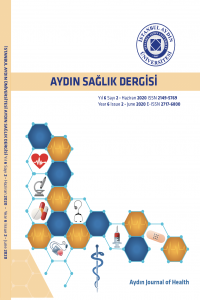Bir Olgu: Organofosfat İntoksikasyonu
Organofosfat, pralidoksim, intoksikasyon
___
- [1] US EPAOmice of Pesticide Programs. FY 2002 Annual Report. Washington, DC:USEnvironmentalProtectionAgency. Availableat: http://www.epa.gov/oppfead1/ [2] Watson WA, Litovitz TL, Klein-SchwartzWe ark. 2003 annualreport of theAmerican Association of Poison Control CentersToxicExposureSurveillanceSystem. Am J EmergMed 2004;22: 335–404. [3] Calvert GM,Plate DK, Das R ve ark. Acuteoccupationalpesticide- relatedillness in the US, 1998-1999: surveillance findingsfromthe SENSOR-pesticides program. Am J IndMed 2004;45: 14–23. [4] Robey WC, Meggs WJ. Insecticides, HerbicidesandRodenticides. In: Tintinalli JE, Kelen GD, Stapczynski JS, eds. EmergencyMedicine: a ComprehensiveStudy Guide. 6th Edn. McGraw-HillCo, New York, 2004; pp. 1134–43. [5] Worek F, Kirchner T, Backer M, Szinicz L. Reactivationbyvariousoximes of Human erythrocyt eacetylcholinesterase inhibited by different organophosphorus compounds. ArchToxicol 1996;70: 497–503 [6] Aygün D. Diagnosis in an acute organophosphate poisoning: report of Three interesting cases and review of the literature. Eur J Emerg Med 2005;12: 102–3. [7] Butera R, Locatelli C, Barretta S. Secondary exposure tomalathion in Emergency department health care workers. ClinToxicol 2002;40: 386. [8] Köksal N, Büyükbeşe MA, Güven A, Çetinkaya A, Hasanoğlu HC. Organophosphate intoxication as a consequence of mouth-to- mouthbreathingfrom an affected case. Chest 2002;122: 740–1. [9] Little M, Murray L. Consensus statement: risk of nosocomial organophosphat epoisoning in emergency departments. EmergMedAustralas 2004;16: 456–8. [10] Thiermann H, Szinicz L, Eyer F ve ark. Modern strategies in therapy of Organophosphate poisoning. ToxicolLett 1999;107: 233–9. [11] Johnson MK, Jacobsen D, Meredith TJ. Evaluation of antidotes for poisoning in Organophorus pesticides. Emerg Med 2000;12: 22–37.
- ISSN: 2149-5769
- Yayın Aralığı: Yılda 3 Sayı
- Başlangıç: 2015
- Yayıncı: İstanbul Aydın Üniversitesi
Bir Olgu: Organofosfat İntoksikasyonu
Ayşin ERSOY, Çağlayan KÖKSAL, Zekeriya ERVATAN, Mensure ÇAKIRGÖZ, Betül SİNOĞLU
27 Hemiarthroplasty For 4-Part Fractures Of The Proximal Humerus: Is It A Good Treatment Option?
Müjdat ADAŞ, İsmail KALKAR, Cem Zeki ESENYEL, Semih DEDEOĞLU, Yusuf ÖZCAN, Kürşat BAYRAKTAR, Murat ÇAKAR, Ayşin ERSOY
Bilimsel Yazı Nasıl Hazırlanır?
İnsan Saçı Örneklerinde Talyumun Katı Örneklemeli Atomik Absorpsiyon Yöntemi İle Tayini
Özofagial Skuamöz Papillom; Nadir Bir Olgu
Uğur KESİCİ, Sevgi KESİCİ, Aygen TÜRKMEN
Son Dönem Hepatik Yetmezlik ve PCC (Protrombin Kompleks Konsantresi-Cofact®) Kullanımı: Olgu Sunumu
Aygen TÜRKMEN, Özgül KIRBAŞ, Mensure ÇAKIRGÖZ, Deniz KARA, Döndü GENÇ KARALAR
Preemptif Analjezide İntravenöz Deksketoprofen İle İntravenöz Tramadol Etkilerinin Karşılaştırılması
Sevgi KESİCİ, Ülkü AYGEN TÜRKMEN, Seray KALYON, Hatice Aysel ALTAN, Uğur KESİCİ
